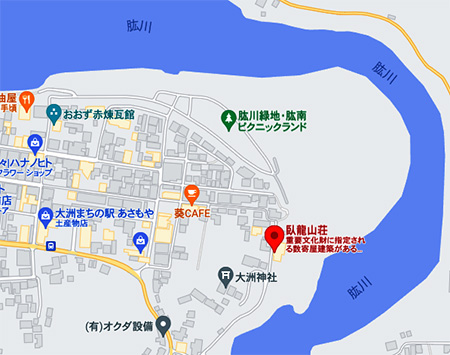

四国探訪篇、愛媛県南部の中心地・大洲にある臥龍山荘。
重要文化財建築で、始原伝承は戦国期の渡邊勘兵衛(了)居宅と伝わる。
渡邊勘兵衛は1601年に禄高2万石で戦国武将・藤堂高虎に将として採用された。
戦国期の武士道、いわば花形スターのような存在。
上方武士道としては大名から高禄で採用されることに「懸命」するのが
この時代の武士の一種のステータスだったとされる。
鎌倉期武士の「一所懸命」とは違う価値観の「懸命」だったと思える。
そのなかで渡邊勘兵衛はその毀誉褒貶が語り継がれる存在。
たくさんの主君に仕えたあと藤堂高虎に高禄で召し抱えられたが、
その後、大阪の陣で主君と決定的な対立をきたし「奉公構」を食らう。
奉公構とは大名家側で解雇した元家臣に対してその再就職の機会を奪う、
許諾なしでは再就職させないという問題家臣への制裁手段。
2万石という家臣としては破格そのものの待遇を得ながら、
その主君への反抗的な主命無視などが重なって数奇な運命を生きた人物。
戦国期の武士道のひとつの典型例として語られるのですね。
この臥龍山荘はかれが居宅としてはじめに造営しその後大洲領主・加藤家などが
「大名庭園」として愛し続け、その後明治になっては新興の木蝋産業での
成功者・河内寅次郎が成金的に入手し京都・桂離宮などを参考にして
贅を尽くした建築・庭園美を造り上げた。
北海道にも皇室建築がありまたニシン御殿のような産業建築もあるけれど、
戦国期以来の歴史が刻まれる建築はさすがに歴史積層の四国。
武家的な建築価値感、日本文化的価値感としていっとき耽溺してみた。
いまわたしたちは住宅性能という異次元の価値感を獲得してきているけれど、
そのデザイン未来形はこの臥龍山荘のような「贅を尽くす」方向に向かうのか、
どんな価値感に向かっていくのか、考えて見る機縁にしたい。


それにしても渡邊勘兵衛の事跡を見るに付け
その破天荒というか、上方武士道ぶりが面白い。
武士道という言葉は江戸期の徳川政権による滅私奉公的な
いわば強制された儒教的倫理観認識が今日の日本人意識に沈殿しているけれど
本来は鎌倉以来の一所懸命やこの渡邊勘兵衛的生き方・高禄で召し抱えられるよう
戦場で「武名を挙げる」ことが誉れであるという価値感が本来的なのだと思う。
秀吉の金ピカ趣味、欲望自然主義的な傾向が本来、典型例だったのだと思う。
自分を高く売ることに懸命に生きてそのことでまた挫折していった渡邊勘兵衛。
その戦国以来の人間的な空気感を感じさせられる。
たぶん明治の産業成功者・木蝋貿易事業者、河内寅次郎もまた、
そういう戦国期の武士的な日本人らしさを追体験していたのではないか。
そんな痕跡を体感してみたいと思います。
English version⬇
[Sengoku samurai’s Life-threatening , Iyo Ozu “Garyu Sanso” ① Shikoku living space exploration-19]
Shikoku exploration edition, Garyu Sanso in Ozu, the center of southern Ehime prefecture.
It is an important cultural property building, and the tradition of the primordial ancestors is said to be the residence of Kanbei Watanabe (Ryo) during the Warring States period.
Kanbei Watanabe was hired as a general by the Sengoku warrior Todo Takatora in 1601 at a height of 20,000 goku.
Bushido during the Warring States period, so to speak, like a flower-shaped star.
As for the kamigata samurai road, it is “Life-threatening ” to be adopted by the daimyo in high grace.
It is said that it was a kind of status of the samurai of this era.
It seems that it was a “Life-threatening ” value that was different from the “Life-threatening ” of the Kamakura period samurai.
Among them, Kanbei Watanabe is the existence that the praise and praise is handed down.
After he served many lords, he was called by Todo Takatora with high dignity,
After that, he had a decisive confrontation with his lord in the siege of Osaka and ate a “service structure”.
The service structure deprives a former vassal who was dismissed by the daimyo family of the opportunity to re-employ.
Sanctions for vassals who are not allowed to re-employ without permission.
While receiving the treatment of 20,000 stones, which is exceptional for a vassal,
A person who lived a strange fate due to the combination of rebellious ignorance of his lord.
It is said as a typical example of Bushido during the Warring States period.
This Garyu Sanso was first built by him as his home, and then by the Ozu lord and the Kato family.
Continued to love as a “daimyo garden”, and then in the Meiji era, in the emerging wax industry
The successful person, Torajiro Kawauchi, obtained it as a riche and referred to Kyoto, Katsura Imperial Villa, etc.
We have created a luxurious architecture and garden beauty.
There are imperial buildings in Hokkaido, and there are also industrial buildings like the herring palace,
The architecture that has been engraved with the history since the Warring States period is truly Shikoku, which is a stack of history.
I indulged in the samurai-like architectural value and Japanese cultural value.
We are now gaining a different dimension of value in housing performance,
Is the design future tense heading in the direction of “doing luxury” like this Garyu Sanso?
I want to think about what kind of value we are heading for.
Even so, to see the traces of Kanbei Watanabe
It’s rather terrible, and the first time in the upper samurai way is interesting.
The word Bushido is a private service by the Tokugawa administration during the Edo period.
So to speak, the forced Confucian ethical perception has settled in today’s Japanese consciousness.
Originally, it seems to be held by the hard work since Kamakura and this Watanabe Kanbei way of life, Takaroku
I think that the sense of value that it is an honor to “name Takeshi” on the battlefield is essential.
I think Hideyoshi’s hobby of gold and naturalism was originally a typical example.
Kanbei Watanabe, who lived hard to sell himself at a high price and was frustrated by that.
You can feel the human atmosphere since his Warring States period.
Perhaps the Meiji industry successor, the Japan wax trader, Torajiro Kawachi, also
Perhaps he was relived the samurai-like Japaneseness of the Warring States period.
I would like to experience such a trace.
Posted on 3月 6th, 2022 by 三木 奎吾
Filed under: 住宅マーケティング, 日本社会・文化研究







コメントを投稿
「※誹謗中傷や、悪意のある書き込み、営利目的などのコメントを防ぐために、投稿された全てのコメントは一時的に保留されますのでご了承ください。」
You must be logged in to post a comment.